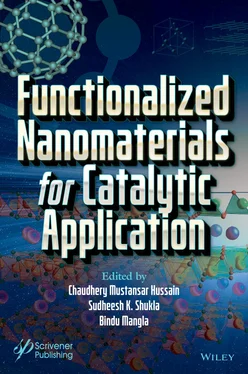1 ...6 7 8 10 11 12 ...18 Figure 1.5 Photocatalytic action with plausible mechanism.
1.5.1 Carbon-Based FNMs as Photocatalysts
1.5.1.1 CNT-Based FNMs
Van der Waals forces, hydrophobicity, and a very poor solubility lead to agglomeration of the NMs. Sometimes, impurities present deliver a poor degrading efficiency of these materials. Surface alteration successfully resolves the problem faced to get better achievements. Functionalization divided into two main segments (1) covalent and (2) noncovalent alters the photocatalytic deliverables when dissimilar functional modules are associated with it. Rh B, an OP, was photocatalytically degraded using visible (>420 nm) light, by the heterostructure Au NPs @ POM-CNTs at room temperature. This tricomponent had 45% degradability [129]. In one of their trials, the authors Xu, Y. et al . witnessed that 0.1% of CNT/LaVO 4FNM could effectively photocatalytically degrade TC (81%) antibiotic that caused harmful effects to water segments [130].
In a similar manner, ZnO/NiO coated MWCNTs photocatalytically degraded (azo dye) MO efficiently, where a comparative study was done by the authors at different combinations of the trio component, at pH 7, for 6 h, using UV (280 nm) and visible radiation (480 nm) [131]. Exposure of hydrothermally formed TiO 2-NRs/CNTs/braced with FeCo-Al 2O 3catalytic agent was a potent remover of MB (97.5%), when the medium was photocatalytically degraded by natural sunlight, was later proved for its sustainability up to six trials with lesser doses in kinetic runs [132]. In a different situation, functionalized MWCNTs/TiO 2got by sol-gel method as per the reporters of El-Sayed, B.A. et al . had a versatile photocatalytic decomposition under variable conditions of sunlight, UV, and Xenon light-irradiation. Later, these were proven for their activity over the textile dye effluents Vat Green dyes and Dianix Blue dye in different trial runs [133].
1.5.1.2 Fullerene-Based FNMs
FNMs of fullerene with exceptional features to modify the strength, stability, photocatalytic ability, and electron (e −) affinity have made attractions as nanocatalyst for photo-degradation of contaminants in water sources [134]. Strong absorptions were seen in the UV belt, while moderate absorptions are seen in visible, functionalization enhances the behavior of electron transference required for photocatalytic action [135]. New novel FNM (covalently bonded) Zn-Porphyrin functionalized/TiO 2synthesized was used to degrade the contaminants MB and phenol, where ·O 2−, ·OH and ·OOH may participate in the reaction kinetics. Appropriate small band difference between FNM’s LUMO and TiO 2’s CB that leads to the electron transference was the cause for degradation according to authors Regulska, E. et al . [136]. In another situation, the authors Chai, B. et al . degraded Rh B by fullerene modified nanocomposites of g-C 3N 4(C 60/g-C 3N 4) photocatalytically, where the efficiency was because of charge separation of photo e −electrons and h +holes in the FNM [137]. In the same way, poly-hydroxy fullerenes (PHF)/TiO 2as PC were found to be effective for decomposition Procion (a red-dye). The molecular interactions between the two were a simple electrostatic force that enabled the composite to undergo surface modification [138]. Fullerene FNM with silanes was proved for its effective photocatalytic activity on phenols for oxidative decomposition [139]. C 70-TiO 2hybridized FNMs were proved stable for its photocatalytic behavior for five recycle runs while decomposing sulfathiazole (sulfonamides drug) a powerful antibiotic [140].
1.5.1.3 Graphene (G)/Graphene Oxide (GO)–Based FNMs
The supply of graphene/graphene oxide–based functionalization resolves the constraints delivered by metal oxide PCs. Of late, attentions are focused on FNMs of graphene/graphene oxide–based semi-conductor materials as functionalized PC due to their smaller size with larger specific surface area supported by high electron (e −) conductivity and high adsorption capacity [141]. Advanced research work has been augmented on MO-G/GO FMNs photocatalytic systems [142] for oxidativereduction of pollutants (BG) [143] and (MB) [144]. The unstable and aggregation tendency of the NMs are retarded by the advantages raised due to FNMs.
In one of their studies, researchers Rao, G. et al . synthesized TiO 2-NW/Fe 2O 3-NP/GO FNM sheets by colloid-blending scheme, where the material was found to have 93% efficacy in getting rid of humic acid from water photocatalytically at a pH 6. TiO 2furnished h +required for ·OH and GO the e −needed for ·O 2−needed for the activity [145]. GO/MCU-C 3N 4/PVDF materials synthesized by vacuumized self-assembly and cross-linking process had exceptional self-cleaning property, which was proven fit for separating oil-in-water colloidal emulsions. Photocatalytic degrading capabilities were attributed to the e −transferences from CB (1.61 eV) to VB (1.18 eV), with π-π* transition giving h +in VB. h +, ·O 2−, and ·OH were controllers in the reaction for eradicating oil-foulants as observed by the researchers Shi, Y. et al . [146].
Scientific workers Gnanamoorthy, G. et al . synthesized AF-Bi 2Sn 2O 7/rGO (AF-amine functionalized) FNMs for photocatalytic degradation of organic dye MB in the visible region was 75% (20 min). Bandgap between pure (2.6 eV) and FNMs (1.6 eV) decreased. VB with h +and CB with e −that favored the reaction were supported by the formation of radicals ·O 2−and ·OH. Stability and reusability of FNMs were persistent up to four cycles [147]. In one of their methods, the authors Liu, H. et al . used FNMs of Bi 2Sn 2O 7/RGO to reduce and degrade Rh B and phenol photocatalytically in the bright visible region (420 nm) and noticed that the degrading efficiencies were 95.8% (125 min) and 81.1% (200 min) for Rh B and phenol, respectively. On embedding RGO on Bi 2Sn 2O 7(pure), they observed that there was a decrease in the bandgap from 2.48 eV (pure) to 1.85 eV FNM which served well for degrading the contaminant, where the active radicals involved for the reaction was h +and ·OH [148].
1.5.1.4 Graphene-Carbon Nitride/Metal or Metalloid Oxide–Based FNMs
Recently, conjugation of C and N in a metal-free graphitic polymer is a hotspot that captivates the research workers to utilize the visible energy for the receptive photocatalytic zone in redemption of water pollutants [149]. Normally, hetero-junctions of g-C 3N 4–based PC are obtained by fusing g-C 3N 4(semiconductor) PC and a co-catalyst (semiconductor). Significantly, type II hetero-junction and Z-scheme PC are predominantly employed by many co-workers for removing OPs. Z-scheme have been extensively utilized in BiOI/Pt/g-C 3N 4[150], MoO 3/g-C 3N 4[151], g-C 3N 4/FeWO 4[152], g-C 3N 4/Ag/MoS 2[153], TiO 2/g-C 3N 4[154], and g-C 3N 4/Ag/Ag 3VO 4[155]. While, straddling, staggered, and broken heterojunctions belonging to type 1, type 2, or type 3, with a small/large bandgap between CB and VB/or CB and VB with high potentials, are used in ZnO/g-C 3N 4[156], Bi/Bi 2WO 6/g-C 3N 4| Bi/Bi 2MoO 6/g-C 3N 4[157], SmVO 4/g-C 3N 4[158], g-C 3N 4/CuWO 4[159], and BiVO 4/g-C 3N 4[160]. Thus, many FNMs have been used in fabrication, to name a few for the removal of organic toxics like MB, MO, Rh B, fuchsin, and X3B form water segments.
Li, H. et al ., fabricated WO 3/Cu/g-C 3N 4nanohybrids to degrade 4-nonylphenol [161]. While, Yang, Y. et al . used Ag@AgBr/g-C 3N 4FNMs as nano-composites to degrade MO [162]. Similarly, the authors Fu, J., et al ., in their recent publication of CdS/g-C 3N 4, demonstrated a comparable output in enhancement-factor as 20.5 and 3.1 for dye-degradation of MO while using the composites of two active semiconductors g-C 3N 4and CdS individually [163]. Later, in another experiment, the authors Yang, Y. et al . investigated SPR results of Ag NMs while studying the performance of Ag-coated-g-C 3N 4over MO dye-degradation [164]. In another situation, researchers Ma, D. et al . revealed that g-C 3N 4/RGO/Bi 2WO 6FNMs that fit the Z-scheme had RGO as a bridge to transfer the e −electrons between the two bands g-C 3N 4and Bi 2WO 6. The photoelectrons formed in the CB of the later Bi 2WO 6moves rapidly into the VB of the former g-C 3N 4(holes) to accumulate sufficient (e −) electrons in the CB of the former and holes of VB in the later. FNMs were found effective to photocatalytically degrade and remove TCP from water [165].
Читать дальше












